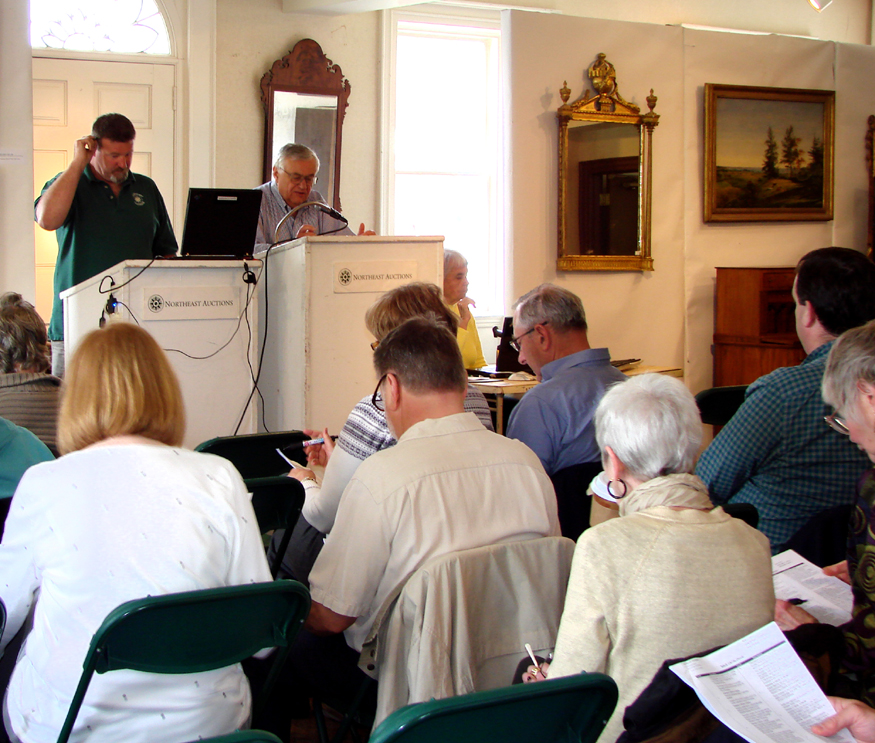Review by Rick Russack,
Photos Courtesy of Northeast Auctions
PORTSMOUTH, N.H. — Northeast Auctions’ low-key sale grossed $541,000 May 15, with two Rockwell Kent paintings together accounting for $282,000 of the total. A good-sized crowd turned out, and bidding was active and competitive on collections of pewter, silver, Liverpool jugs, Oriental ceramics and furniture. Several items far eclipsed their high estimates. Having said that, there were numerous good buys and three dealers in the room each bought multiple lots.
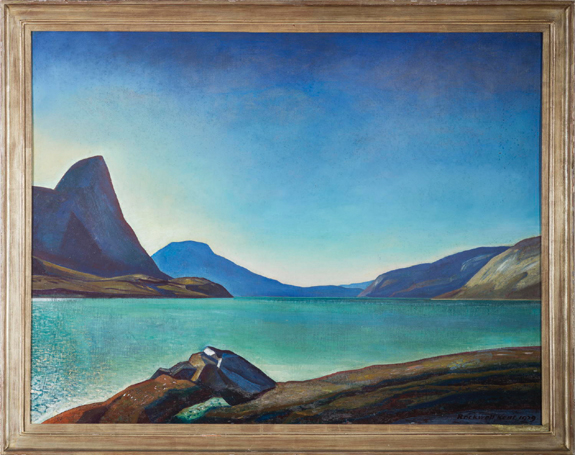
The star of the sale was Rockwell Kent’s large painting of a scene in Greenland, dated 1929. After being shipwrecked off the coast of Greenland, Kent stayed for two months, bought painting supplies in a nearby town and painted this view labeled “Godthaab Fiord.” Two other paintings done at the same time hang in Eastern European museums. It attained $180,000.
In 1929, Rockwell Kent and two friends were shipwrecked off the coast of Greenland. His friends returned home but Kent loved the area and remained for about two months. He purchased necessary painting supplies in Godthaab and, as he later wrote, “was soon well equipped to go to work as if no mishap had ever occurred.” “Godthaab Fiord,” a large oil on canvas mounted on plywood, was one of the paintings he completed while there. Kent also did at least two other paintings during that, his first, stay on the island, and when he returned home the three paintings were exhibited at the Carnegie Institute in Pittsburgh.
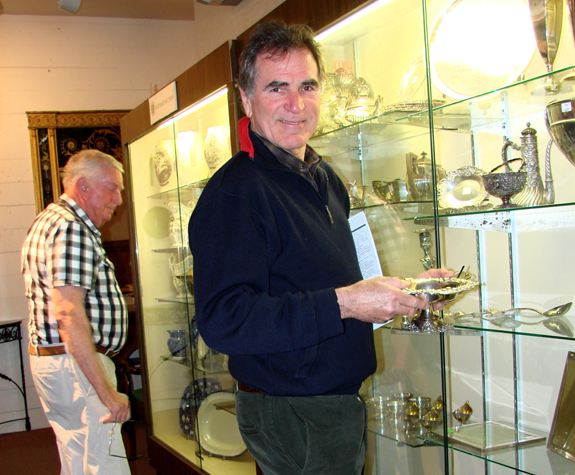
Exeter, N.H., dealer Peter Sawyer was going over some of the silver in the sale. He bought the John Blunt decorated fire bucket and left immediately after.
Reviews of the paintings were very complimentary. Royal Cortissoz, writing in the New York Herald Tribune, said, “Rockwell Kent fortifies his impressions of Greenland, not only with what one feels is the truth, but with his powers of design and draughtsmanship.” The other two paintings Kent exhibited are now in Eastern European museums; this was the only one to remain in Western hands. The painting, 34 by 44 inches, signed and dated, opened with a left bid and was sold to a phone bidder for $180,000. Another Kent painting, the same size, of Vermont’s Green Mountains, brought $102,000. Both had been in the collection of Donald Brace, co-founder of publisher Harcourt-Brace.
Selling for more than ten times its high estimate was an exceptional 20¾-inch-tall blue and white Chinese porcelain vase from the Qing dynasty, dating probably to the second half of the Nineteenth Century. Realizing $13,200, it was bought by Josh Chamberlain, Chamberlain Antiques, Amherst, N.H. Contacted after the sale, Chamberlain said, “It was an unusually large size and style and the decoration was very well done. It also had a very good provenance and I was glad to be able to get it.” Chamberlain’s representative in the room competed with a determined phone bidder, who eventually surrendered.
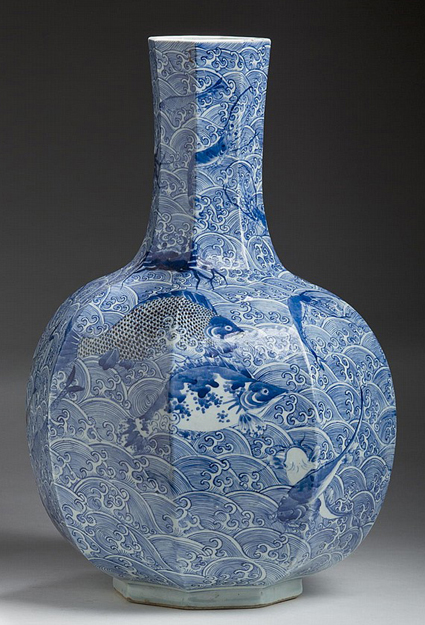
Josh Chamberlain, an Amherst, N.H., dealer, paid more than ten times the estimate for this Chinese porcelain blue and white vase, 20¾ inches tall, which finished at $13,200. Chamberlain said it was an unusual size, well decorated and had a very good provenance.
The sale included Rose Medallion, green Fitzhugh and other Chinese export porcelain, along with other Asian objects. A hand mirror with a carved celadon jade inset depicting a scholar and student walking along a path achieved $3,240. A circa 1724 export porcelain enameled, rouge-de-fer teapot stand with the arms of Frederick, Baronet of Westminster, went for $540, and a 15-inch Rose Medallion platter, in a lot with two covered vegetable dishes, realized $690. An oval green Fitzhugh platter, along with an oval dish and a shrimp dish, achieved $1,080, while a set of 12 83⁄8 -inch green Fitzhugh soup bowls earned $1,200. There were some good buys in the blue Canton category. For example, a lot of 17 butter pats ($150/250), fetched only $60 for the lot — less than $4 each. That caused Ron Bourgeault to say, “These used to be rare.”
The sale started off with several lots of pewter. Apparently a good part of the crowd in the salesroom had come for the pewter, and bidders in the room actively competed with phone and Internet bidders. A Boardman & Co, New York, church flagon and a pair of chalices finished at $840, and a lot with a teapot attributable to the Boardman family sold for $780, along with two pewter syrup pitchers. Two pewter whale oil lamps with domed bases, made by Eben Smith, Beverly, Mass., brought $390. Smith had been an employee of noted pewterer Israel Trask. Each was marked “E. Smith.” English pewter did well with a Guernsey measure, or flagon, probably made by Ann Carter, circa 1800, selling for $600, along with a naval rum jug.
A group of Liverpool jugs with historical American transfers, other historical ceramics and pearlware decorated with enameled American eagles were a continuation of a collection that had been sold late last year. The Liverpool jugs, for the most part, went out below estimates, at prices that dealers buying for resale could afford. An 11-inch jug with a black transfer “By Virtue and Valour-Extended our Commerce” on one side and a portrait of George Washington on the other, inscribed “Benjamin Butler” under the spout, went for $690.
A slightly smaller jug with a transfer scene, “Memorial to George Washington” on one side and a Great Seal of the United States on the other, sold for $780. Several other jugs sold in the same general price range. Eliciting more interest was a circa 1802–15 97⁄8-inch creamware enamel-decorated plate with a black transfer of the Great Seal, lettered “Peace, Commerce and Honest Friendship…..Jefferson.” The plate went for $1,920.
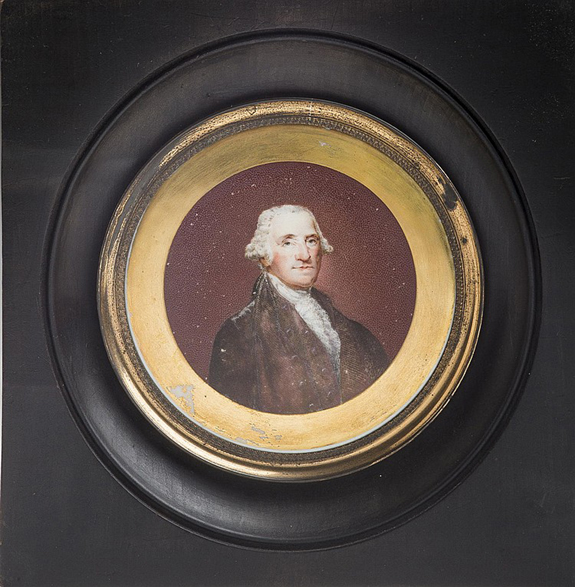
When Lafayette visited America in 1824, French porcelain makers created keepsakes for the occasion. A pair of French porcelain portrait plaques, depicting Washington and Franklin sold for $9,600.
The collection included a number of pearlware plates decorated with underglaze eagles, some of which were illustrated in David and Linda Arman’s book, Anglo-American Ceramics. A 9-inch plate with a green shell-edged border and a displayed eagle bearing a striped, earned $780, while an 8¾-inch plate, painted with an underglaze Great Seal and displayed eagle, reached $720. Historical blue Staffordshire pieces included a 165/8 -inch platter, “States, America and Independence Series,” with a mansion and two swans, which went to a phone bidder for $1,140. It was made by James and Ralph Clews, 1819–36. After the sale, one of the dealers who bought several pieces, including some of the Liverpool jugs, told Antiques and The Arts Weekly, “I was surprised to be able to buy the jugs. When they’ve been sold here in the past, the prices were too high for me to buy for resale.”
As always, there were numerous unusual items and as usual, they did well. Peter Sawyer, an Exeter, N.H., dealer, left immediately after he paid $7,680 for a circa 1818 fire bucket decorated by noted folk artist John S. Blunt. The bucket was decorated with the cooper’s coat-of arms, held by an eagle with ribbons in his talons, which were lettered “Robert Neal.” Above the eagle, was lettered “Mechanic Fire Society.” Sold with the bucket were some ephemeral items related to the society. This fire bucket, which had previously been sold by Bourgeault in 1974, will be included in the catalogue raisonné being prepared by Deborah M. Child, author of The Sketchbooks of John Samuel Blunt.
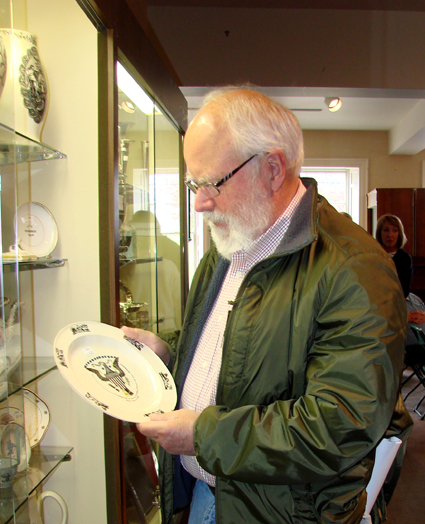
Fitzwilliam, N.H., dealer Dennis Berard specializes in early English ceramics. He is examining a creamware plate with a black transfer of the Great Seal.
An Arts and Crafts spun silver-gilt presentation bowl and cover, circa 1919, by Marie Zimmermann (American, 1878–1972), went for a surprisingly low $600. Zimmermann was a painter and sculptor but is best known for her metalwork and jewelry. Her works were widely exhibited during her lifetime, she won numerous awards and her works are in the collections of the Metropolitan Museum of Art and several other museums. Cast iron garden items were led by a 29-inch-tall cast iron figure of a male Labrador retriever. He was 48 inches long and one of several phone bidders took him to $4,800. Selling for more than four times its estimate was a circa 1820–30 pair of French polychrome porcelain plaques with portraits of George Washington and Benjamin Franklin. According to the catalog, when Lafayette visited America in 1824, French porcelain makers produced numerous such portraits and decorated vases for the American market. Each was 3¾ inches in diameter and in ebonized wood frames. The pair reached $9,600.
There were two unusual textile items. A tapestry fragment, 89 by 46 inches, cataloged as a Franco-Flemish millefleur tapestry panel, brought $7,440 against an estimate of $900. The catalog entry did not indicate a date or provide other information. The buyer said he thought it was Eighteenth Century but it may have been quite a bit earlier. A Google search reveals that this type of tapestry work was done in the Fifteenth–Sixteenth Centuries. A 2006 catalog entry from Sotheby’s says, “Millefleur tapestries, literally meaning ‘a thousand flowers,’ were largely woven between 1400 and 1550 and have always been considered a rare category of late medieval hangings.” An early sampler, in a shape not often seen, also exceeded its estimate. Dated January 30,1755, worked by Elizabeth Lewis Odell, the needlework band sampler was 36½ by 9½ inches. It was stitched with bands of floral and grapevine motifs, with alphabets, numbers, drawn and cutwork. It realized $1,800.
After the sale, Bourgeault told Antiques and the Arts Weekly that he was quite pleased. “The sale was smaller than most of our sales, with only 344 lots. Only six lots were passed during the sale and three of those sold immediately after the auction. The Rockwell Kent Greenland painting was an important painting and I was glad to be able to handle it. All in all, it was a good day and I think both my consignors and the buyers were pleased.”
All prices reported include the buyer’s premium.
For additional information, www.northeastauctions.com or 603-433-8400.

